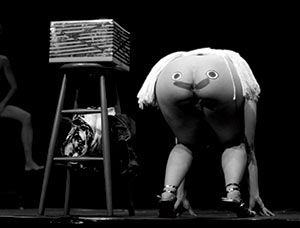Program
Thursday, January 22
RON ATHEY ARTIST TALK/BOOK SIGNING AND RECEPTION
FIFTH PARALLEL GALLERY // RIDDELL CENTRE
UNIVERSITY OF REGINA // 3737 WASCANA PARKWAY // 1:00 – 3:00PM FREE!

Ron Athey is an iconic figure in the development of contemporary art and performance. In his frequently bloody portrayals of life, death, crisis, and fortitude in the time of AIDS, Athey calls into question the limits of artistic practice. These limits enable Athey to explore key themes including: gender, sexuality, SM and radical sex, queer activism, post-punk and industrial culture, tattooing and body modification, ritual, and religion.
Take part in this rare opportunity to hear one of performance art’s most compelling and engaging figures as he takes us through his work from the nineteen eighties to the present.
Afterward, join us for a reception where Ron will be on hand to sign the recent publication about his work. See details below.
Pleading in the Blood: The Art and Performances of Ron Athey
Edited by Dominic Johnson
ON SALE FOR $40 – AVAILABLE THROUGHOUT THE FESTIVAL
This landmark publication includes Athey’s own writings, and commissioned essays by maverick artists and leading academics. It showcases full-colour images of Athey’s art and performances since the early 1980s, including extensive documentation of solo performances and ensemble productions, and his photographic collaborations with other visual artists.
Pleading in the Blood includes three newly commissioned essays on different aspects of Athey’s work by Adrian Heathfield, Amelia Jones, and Dominic Johnson. These scholarly essays are complemented by shorter texts by Homi K. Bhabha, Jennifer Doyle, Tim Etchells, Guillermo Gómez-Peña, Matthew Goulish, Lydia Lunch, Juliana Snapper, Julie Tolentino, Alex Binnie, Catherine (Saalfield) Gund, Bruce LaBruce and Catherine Opie, along with a hand-written text from Robert Wilson. The book also includes Athey’s own writings, including new pieces and hard-to-find archival texts. The publication is lavishly illustrated with full-colour images by photographers including Catherine Opie, Manuel Vason, Elyse Regher, Slava Mogutin, Dona Ann McAdams, Bruce LaBruce, Rick Castro, Sheree Rose, Edward Colver, Jennifer Precious Finch, and others. Antony Hegarty (Antony and the Johnsons) has written a foreword to the publication.
At long last, Dominic Johnson’s book begins the dauntingly exhilarating task of assessing the richly provocative art of Ron Athey. Incorporating Athey’s own prose version of his extraordinary childhood, astute critical essays, and moving appreciations from other artists, Pleading in the Blood advances Performance Studies and Art History by forging a mode of commentary expansive enough to address an artist who consistently works to expand the intricate drama of human embodiment. Athey’s art refuses the usual distinctions between pleasure and pain, or faith and doubt, and has been both blamed and celebrated for its radical inquiries into the limits and possibilities of queer bodies. Athey emerges from these pages as one of the most compelling theatre artists of our time.
- Peggy Phelan, Stanford University
Ron will perform on Saturday, January 24 @ Artesian.
Performances
NEUTRAL GROUND GALLERY // 1856 SCARTH ST. SECOND FLOOR
DOORS OPEN AT 7:30PM // PERFORMANCES FROM 8:00PM – 12:00AM
PERFORMANCES CONTAIN GRAPHIC AND EXPLICIT IMAGERY AND SCENARIOS - VIEWER DISCRETION IS ADVISED
FLOWERS - JESS DOBKIN

A short performance film re-imagining Streisand and Diamond’s hit duet, "You Don’t Bring Me Flowers."
THE HUMAN FACTOR – ANYA LIFTIG

I want to attempt to make love with nature in the most authentic and empathetic way that I can. I want to explore the pain and embarrassment involved in trying to connect in any type of relationship, what folly it feels like, how high the stakes are and how much it sometimes hurts.
HOMAGE – KRIS GREY

In Homage, I position myself in a state of extreme vulnerability. This is a tool I use to engage empathetic connection with the audience. Much of the American Trans* experience is predicated on medicalization and pathology. My chest has long been a sight of trauma and psychic energy. When I had my top surgery, there were 10 days between the removal and the reveal. During that time I was bleeding through my bandages but I couldn’t open them to see my chest. It was the only time in my memory that there was a part of my adult body I didn’t know or couldn’t see. I was having dreams in which I would be outside myself watching my chest weep blood. It terrified me. I told no one. In Homage, I open my own body to regain a sense of agency, irrigate a site of trauma, and to invite an audience to enter into my body via a new queer orifice of my making.
DIRTY PLOTZ - JESS DOBKIN
HOW FUCKING LOUD DO I HAVE TO YELL – HOMO MONSTROUS

How fucking loud do I have to yell is a necessary temper tantrum provoked by years of abuse, violence, erasure, and entitlement to our bodies/voices. It is a pathetically weak invocation towards an end that is never achievable - one in which transfeminine and intersex bodies are not treated as monstrous abominations, but as facets of celebrated human reality. We explore the limitations of our voices as they are swallowed up in a wave of screeching guitars and electronic noise; a sonic background whose purpose is to outvoice us. How fucking loud do I have to yell attempts, and ultimately fails, to encourage cisnormative, dyadic, and masculine expressions to shut the fuck up and listen for once.
How fucking loud do I have to yell to get you to even use my real name? To stop apologizing and just do fucking better? To stop killing people like us? Legitimacy is not granted to loud voices. It is granted to experiences that are the most like those in power. Your voice makes me lose mine.
RON ATHEY photos by Manuel Vason // JESS DOBKIN photos by Tania Anderson
